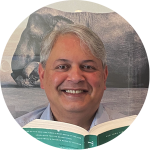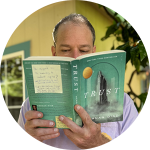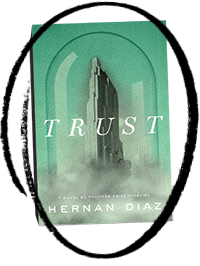Welcome to the 2024 Deep Read!
This is the first of four emails exploring Trust by Hernan Diaz. Our goal is to enhance your reading experience by sharing insights, observations, and questions raised by faculty and writers here at UC Santa Cruz and by your community of fellow Deep Readers in Santa Cruz and around the world. Today, we meet the folks who will help us better understand the novel over the next month. We’ll also set up the first section of the book with a discussion of Hernan Diaz and the literary tradition that he is engaging with in Trust.
Meet the Faculty
We have an excellent lineup of faculty members who will be participating in our upcoming Faculty Salon on May 6 and providing insights for these weekly emails.
 Lori Kletzer is a labor economist and a campus leader in her role as Campus Provost and Executive Vice Chancellor. She’ll provide needed context to many of the economic ideas explored in the novel, which depicts the ways financial systems are organized and how financial capital relates to labor and everyday reality.
Lori Kletzer is a labor economist and a campus leader in her role as Campus Provost and Executive Vice Chancellor. She’ll provide needed context to many of the economic ideas explored in the novel, which depicts the ways financial systems are organized and how financial capital relates to labor and everyday reality.
 Laura Martin is the Deep Read Program Manager and teaches the undergraduate Deep Read course at Porter College. She is a literary scholar, writer, and teacher, and holds a PhD in Literature from UC Santa Cruz. She’s been a key part of the Deep Read since its launch and her literary training and interests keep the Humanities central to every book we read together.
Laura Martin is the Deep Read Program Manager and teaches the undergraduate Deep Read course at Porter College. She is a literary scholar, writer, and teacher, and holds a PhD in Literature from UC Santa Cruz. She’s been a key part of the Deep Read since its launch and her literary training and interests keep the Humanities central to every book we read together.
 Madhavi Murty is a Feminist Studies professor who focuses on questions of nationalism, globalization, and popular culture. These issues permeate Trust, and Murty will offer insights into the ways the novel both constructs and deconstructs national mythologies around political economy and how gender informs the development of these narratives.
Madhavi Murty is a Feminist Studies professor who focuses on questions of nationalism, globalization, and popular culture. These issues permeate Trust, and Murty will offer insights into the ways the novel both constructs and deconstructs national mythologies around political economy and how gender informs the development of these narratives.

Dard Neuman is a professor of Music at UC Santa Cruz. He’ll bring his historical and theoretical expertise to bear on the depiction of music in the novel. With his help, we’ll both read and listen to Trust more deeply, exploring the impact money has on music in the novel and what their relationship tells us about the role of philanthropy in music as well as in art more generally.
 Zac Zimmer is a Literature professor and the 2024 Deep Read Faculty Lead. His recent research interests have centered on reading in communities as a way to facilitate interdisciplinary discovery. As a literary scholar, Zimmer will offer insights throughout the program on Trust’s and Diaz’s many connections to other writers, texts, and important contexts.
Zac Zimmer is a Literature professor and the 2024 Deep Read Faculty Lead. His recent research interests have centered on reading in communities as a way to facilitate interdisciplinary discovery. As a literary scholar, Zimmer will offer insights throughout the program on Trust’s and Diaz’s many connections to other writers, texts, and important contexts.
We’ve also enlisted a group of faculty from the Humanities who will offer commentary throughout our weekly emails. Chris Connery (Literature), Carolina Flores (Philosophy), and Susan Gillman (Literature) will be offering insights into various aspects of Trust.
A Focus on Craft
Given Trust’s experimental approach to the novel, we’ve organized a group of UC Santa Cruz-affiliated novelists to help us all think about Diaz’s writing craft. Micah Perks (Professor of Literature and Creative Writing), Elizabeth McKenzie (Merrill ’81, Literature), and Maria Pachon (Literature PhD student in the Creative/Critical Writing Concentration) will discuss the techniques deployed in the novel and highlight creative dimensions of the book. Join them on April 30 for an online Craft Salon.
Framing the Novel
Now that you’ve met the scholars and writers who will be sharing their perspectives throughout our exploration of Trust, let’s begin our discussion of the book with some help from UC Santa Cruz Literature scholars. At this point, we hope you’ve at least started the first section, Bonds. One thing that becomes apparent from that section’s title page is that Bonds: A Novel by Harold Vanner is somehow a different novel living inside the novel Trust by Hernan Diaz. Literary scholars call this a “framing” device, and it can serve many purposes,  one of which is to add a layer of external reality around a fictional tale. Adding this layer of external reality can make the overall context of a novel seem more intimate, real, and “true,” but it also can introduce a relationship between reality and fiction at the level of a novel’s form. Such is the case with Bonds, embedded within Trust.
one of which is to add a layer of external reality around a fictional tale. Adding this layer of external reality can make the overall context of a novel seem more intimate, real, and “true,” but it also can introduce a relationship between reality and fiction at the level of a novel’s form. Such is the case with Bonds, embedded within Trust.
You may have noticed that the titles of both novels—Bonds and Trust—are words that mean at least two different things: they name financial instruments, and they also describe components of human relationships. This is an additional level of the novel’s framing device: Diaz is calling attention to how money and capital also work to frame the way we understand the story. We’ll see, for instance, how the financier protagonist of Bonds, Benjamin Rask, uses money, something Diaz calls a “public fiction,” as well as financial instruments to influence historical events, like the 1929 crash, and, at the same time, weave layers of fictions around himself that make him impervious to the history unfolding around him. The financier of Bonds is a figure made from the interlacing threads of fiction and reality who perpetuates myths of his outsized stature that, as Diaz writes, “lifted him to divine heights” in the public eye. Does Benjamin Rask, our fictional character, have a counterpoint in reality?
Novel Trajectories
Literature professor Susan Gillman touches on the issue of framing in Trust and speaks about the nature of characterization in Bonds, offering this insightful introduction:
The opening section is imagined as a novel-within-a novel, Harold Vanner’s Bonds, a fictitious 1937 best-seller about the rise of a Wall Street tycoon named Benjamin Rask and his wife, Helen Brevoort, the brilliant daughter of Dutch-descended New York aristocrats, now declining into genteel poverty. This historical novel set in 1920s New York City features money as a main character—while the Rasks and everyone else in Vanner’s novel may seem to lack the vitality of money. Readers get no access to their inner lives or even to their voices. In fact, there are no lines of dialogue at all except for Rask’s one-word, “I,” spoken when he and Helen first meet alone in his townhouse—with no “rest-of-his-sentence” (about which she is described as “curious”) following that first-person subject! Vanner’s neutral narration makes the flat world of distanced and dispassionate Bonds the perfect, open gateway to the rest of Trust. Readers can judge for themselves whether and how much the three subsequent parts fill in the first.
As Professor Gillman explains, Bonds is a realist novel but one that trades character interiority for a distanced, “neutral narration.” This flat neutrality highlights distance and dampens emotion, creating a fictional world organized around objective historical events that seem to anchor this fiction but, as she cautions, may not be so anchoring as we read on.
Bonds circles around 1920s New York, gesturing forward to World War 2 and reaching back to the Gilded Age, an era of extreme economic expansion and income inequality. Edith Wharton’s novels The Age of Innocence (1920) and House of Mirth (1905) are both set in the late Gilded Age world. Literature professor Zac Zimmer offers this literary and historical framing with references to Wharton: “Diaz is giving us the moment in the 1920s through the interwar period where finance is exerting itself in its geopolitical guise through new financial instruments. Trust is talking about the late-19th and early 20th-century financialization of the economy and the shift from a production focus to a finance focus, which changes the New York City of Edith Wharton into something else.” According to Zimmer, Trust is exploring a shift both in the way our financial system works and in the way stories are being told and novels written. Bonds, the novel-within-a-novel, is setting the stage for these literary and historical shifts, which Trust explores in subsequent sections.
 But we are getting ahead of ourselves. For now, let’s focus on Bonds, a tale of wealth and manners written in the style of Edith Wharton and Henry James. As Professor Gillman notes, there is almost no dialogue in Bonds and the story is told in summary episodes rather than scenes. It is not a superficial tale, but it is certainly a story about surfaces, appearances, and customs. For lovers of realist fiction and tales of Old New York, there will be a lot to enjoy. But as the framing device implies and Professors Gillman and Zimmer suggest, there’s something else going on here, and not everything is as it initially seems.
But we are getting ahead of ourselves. For now, let’s focus on Bonds, a tale of wealth and manners written in the style of Edith Wharton and Henry James. As Professor Gillman notes, there is almost no dialogue in Bonds and the story is told in summary episodes rather than scenes. It is not a superficial tale, but it is certainly a story about surfaces, appearances, and customs. For lovers of realist fiction and tales of Old New York, there will be a lot to enjoy. But as the framing device implies and Professors Gillman and Zimmer suggest, there’s something else going on here, and not everything is as it initially seems.
Diaz himself gestures toward what this something else is in a comment on Wharton and James in a recent interview in The Paris Review on Trust:
In Wharton and in James, we see the formal precepts of realism taken to their absolute limit—the breaking point before modernism. The traditional nineteenth-century novel aspired, for the most part, to reflect the world objectively. Stendhal famously wrote that the novel is a mirror carried along a road, which sums it all up. But toward the end of the nineteenth century, I think many novelists were turning that mirror away from the road and toward its bearer. Who is looking at the world and how is this observer, too, part of the picture? Eventually, the mirror shattered and the novel found itself looking at the scattered reflections on the shards. As literature no longer was required to reflect a cohesive, unified world, the gaze also began turning inwards. I’m abusing Stendhal’s simile and presenting all this in a rather schematic, linear fashion. But I think that toward the end of this trajectory, where I would place James and Wharton, the novel is trying to do things that were unimaginable a few decades earlier. More than accurately depicting objective reality, the emphasis was on conveying certain forms of experience.
Diaz is self-consciously building on the literary traditions he is engaging with in Trust, such as the late realist fiction of Wharton and James. We should keep his conception of the novel’s role in depicting a non-unified world, the “scattered reflections” of the shattered “mirror,” in mind as we read, asking ourselves what his novel is suggesting about objective reality and noting what forms of experience it is interested in conveying. How is this novel inviting us to consider reality? What is reality in this novel? What is fiction? How is this novel framing our experience of it, and, thus, what is it allowing or disallowing us to feel and think?
While there’s no single correct answer, it will be helpful to ask yourself why the story is unfolding in the way it is, why Diaz begins with Bonds, and what it means to begin a novel with a fiction-within-a fiction.
Community Conversations
What’s really great about Trust is that it has much to offer, even if you aren’t aware of Diaz’s use of framed narratives, the relationship between fiction and reality, or the literary and historical references of the time period. We share these perspectives, as always, to give you different avenues for understanding the text and to highlight the ways that a humanistic approach as well as other disciplinary approaches can help you see texts and the world in new and deeper ways.
We encourage you to share your observations of Bonds with a comment on our web page. What did you like about Bonds? Was this novel written in a familiar style? Was it entertaining? Did the historical character of the novel make it easier or harder to understand? What do you think about the way the story is being told and how it is framed? Did you read the world of Bonds as a cohesive one? Finally, what does it mean for a book written in the 2020s to adopt a style of writing from the 1920s and earlier?
Feel free to pose other questions, respond to others, and offer your ideas in the comments section below. We’re looking forward to reading and thinking through this book with you!